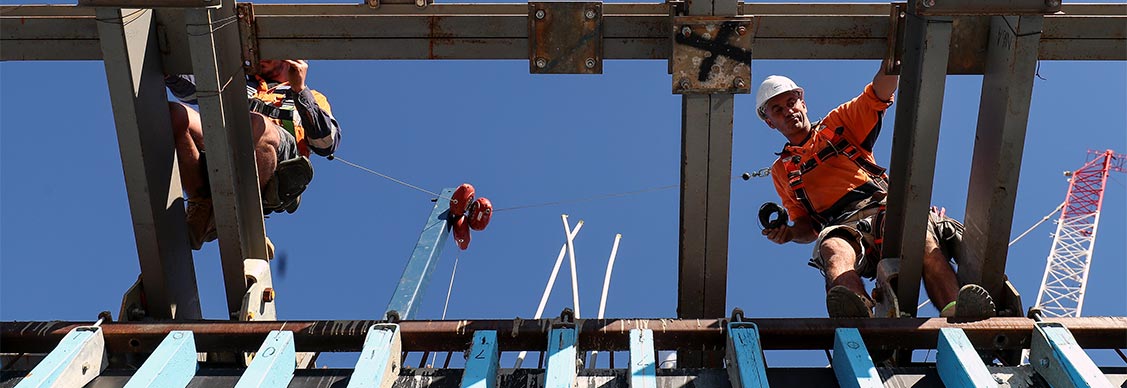Steeling for near-term construction and supply chain challenges
High steel and lumber costs expected to drop by summer
Lumber and steel shortages in the U.S. are spiking prices and lead times for key construction components, leaving some pandemic-challenged developers on pause, while others push ahead.
Lumber prices grew 86% from April 2020 to April 2021, according to the latest data from the Bureau of Labor Statistics. Prices for steel products increased 67% during the same period.
To put those numbers into perspective, the highest year-over-year increase seen over the past decade for either material was roughly 20%, and long-term cost growth has averaged between 2% to 5% a year, says Henry D’Esposito, Senior Research Analyst, Construction, JLL.
“Material cost growth is expected to outpace all other elements of construction cost increases this year,” D’Esposito says. “Some developers who were already taking a wait-and-see approach to projects during the pandemic are hesitant to jump back in for fear of buying at the top of the market.”
Supply chain struggles
The U.S. produces most of its steel and lumber domestically. But domestic production has been slow to ramp up since pandemic-related shutdowns last year.
In addition to plants operating at reduced capacities to allow distancing, the shortage was caused by an expectation that demand would go down due to a pandemic-fueled recession, D’Esposito says. For a while, steel demand did go down, and producers idled roughly one third of their capacity, but it was followed by an economic turnaround so fast that it “caught the supply side by surprise.”
The demand for lumber, however, did not even temporarily dip. Instead, it rose over 15% during the height of pandemic lockdowns as single-family home construction, the biggest user of lumber, boomed, and retailers adopted to pandemic restrictions by building outdoor dining patios.
“Now non-residential construction is going up too, so there was never really a pause to rebuild the lumber supply,” D’Esposito says.
Major commodities firms are forecasting that the second quarter of 2021 will represent a peak in steel pricing, and that prices will decline in the second half of the year.
“Our recommendation for construction firms is to secure supply of critical materials needed in the coming two quarters, as continued shortages are possible,” D’Esposito says. “However, avoid locking in any long- or medium-term prices at current levels.”
To build or not to build
The average commercial building project now costs 4 to 7% more due to the shortages. Skilled labor shortages are compounding the impact, increasing building costs an added 2 to 5%.
Whether builders decide to remain on the sidelines or push ahead really depends on the sector, as well as individual preferences, says Eric Enloe, Managing Director, Valuation and & Advisory Services, JLL.
Looking for more insights? Never miss an update.
The latest news, insights and opportunities from global commercial real estate markets straight to your inbox.
The slowdown had been more visible in the retail sector due to the “challenging retail climate and economics” but vaccine rollouts and easing restrictions on capacities has that sector powering up once again.
And then there’s industrial. Activity has not slowed in the industrial space, “because the market is so active with demand outstripping supply,” Enloe says.
“Construction costs are not inhibiting industrial,” he says. “The sector is fascinating right now because the existing product is so expensive that many are open to the greater risk and greater reward of new development. There are buildings selling empty at a price you would expect leased, with the buyer taking on the leasing risks.”
While the cost of multifamily construction is rising, many construction projects are pushing ahead in active suburban markets while urban construction is delayed, he says.
Because the return to office is still underway, there is not a lot of new office construction and it is less impacted by the shortages. However, the price of tenant buildouts — construction of the interior of company’s offices — has risen sharply.
Landlords are being very competitive with regards to tenant improvement allowances, Enloe says.
“A lot of companies want to renovate to serve changing needs in workplace,” he says. “But the cost of tenant buildouts has gone up and that is challenging on the economics.”
Investment Opportunities
Forecasts
Additional steel supply coming online in the second quarter — due to production ramping up — is expected to lower prices, D’Esposito says. However, 2021 prices are expected to remain far above the 2020 average.
The shortage of fabricated steel parts may create significant lead times that put projects at risk of being delayed.
“Despite elevated prices and longer lead times, lumber availability is not expected to be a critical issue,” D’Esposito says.
While commodities prices are rising globally, the shortages and price spikes have hit the U.S. hardest to date. Prices in other countries have increased but are below current U.S. prices, which could lead to an increase in imports.
聯繫 Henry D’Esposito
Senior Research Analyst, Construction, JLL, JLL Asia PacificWhat’s your investment ambition?
Uncover opportunities and capital sources all over the world and discover how we can help you achieve your investment goals.




